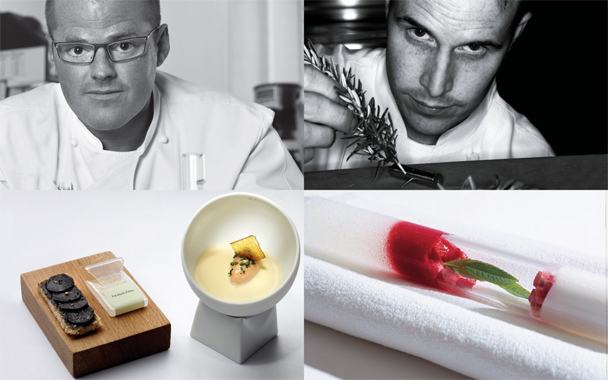As chefs of two of the world’s most influential, risk-taking restaurants, Grant Achatz and Heston Blumenthal are often compared to one another. Now, it turns out, Achatz’s Alinea Book and Blumenthal’s Big Fat Duck Cookbook are scheduled for release within a week of each other this fall—and they have taken very similar approaches to translating their cuisines into print. Gourmet’s Christy Harrison spoke with the chefs about the writing process, the audiences they hope to reach with their books, and their feelings about the term “molecular gastronomy.”
Heston Blumenthal: How are you doing, Grant? How’s your health—I’ve heard you are doing much better?
Grant Achatz: Oh yeah. Cancer, that’s nothing, man.
HB: So fully on the mend?
GA: Yeah, it’s completely gone. Now I just need to try to gain some weight back, which isn’t too difficult, to be completely honest with you. I just eat a lot of ice cream.
HB: Wow, that’s incredible. I wonder how much of [your recovery] is kind of mind over matter.
GA: Well, obviously I credit the doctors, and they’re phenomenal. But everyone was kind of surprised that it happened so quickly and that I responded to the treatment so well.
HB: That’s fantastic news. I’m really glad to hear it.
Christy Harrison: Me too. And now you’re hard at work on your cookbook, I understand. It’s interesting that you both have books coming out at the same time. Grant, you’re going a nontraditional route with yours—you’re self-publishing, and you’re also publishing the exact recipes used in the Alinea kitchen instead of tweaking them for the home cook. What were the reasons for that choice?
GA: For us, we felt the most important thing was to express the restaurant in its most accurate fashion, and try to convey to the reader what Alinea and the food are all about. We felt that if we eliminated some of the techniques because they were too difficult, or some of the ingredients because they were too hard to find, then you would be left with something that’s not representative of the restaurant or of the cuisine itself. So our effort was to convey the emotion, the expression, the essence of the restaurant, and also hopefully—if the recipes are written well enough—to dispel the myth that cooking in this style is impossible for somebody who isn’t a professional cook. I think that people will be surprised when they see the recipes written step by step—it’s really not that hard to do. Of course we’re going to have the typical source guide telling you where to find some of the ingredients; and obviously most folks aren’t going to have a Pacojet or a rotary meat slicer at home, and so we’ll offer ways to get around that. And in some cases we’ll have to say that if you don’t have, say, a Pacojet or liquid nitrogen, you’re not going to be able to do this. We felt that was okay in these cases, because there are so many recipes in the book that it really boils down to how ambitious people want to get in their own kitchens.
CH: Heston, are you planning something similar in your cookbook?
HB: Yeah, I’m completely with Grant on this one—we’re making absolutely no concessions whatsoever. We’re printing exactly the recipes [we use in the restaurant]. We went through a whole process—as you know, Grant, when you’re working in the kitchen you don’t make things for four people, you don’t start the whole thing from scratch. We started looking at reducing some of the quantities down to a more manageable size, but we found that if you started to divide the various ingredients and scale a recipe down for four or six people, if you had [an ingredient] like gelling gum, which you use in small quantities [anyway], you might end up with something like 0.021 grams. So we actually decided to make a caveat at the beginning of the recipe section that these are literally Fat Duck recipes stuck in the book. And Grant, I agree about the book needing to be an expression of the restaurant, and of you as the brains behind it. If you look at your food, you see that actually you don’t wake up in the morning and say “I’m going to have a go at this today.” It’s not a random process; often it’s something that’s been kind of bubbling away in the back of your mind for months. And I think those thought processes can be fascinating for the reader. To see the journey the dish goes through, to see how we take an idea or a concept or a technique and farm it out to different dishes, where it gets tweaked and honed. I just think that having that knowledge, putting that across, gets under the skin of the chef. We have a lot of that in the book.
GA: For us, we even went as far as breaking a pretty major rule here in the States: We’re doing all the recipes in Metric.
HB: Is it common to find recipes in grams and cups?
GA: That’s kind of what they wanted us to do at the beginning. Ten Speed Press is distributing the book—we’re self-publishing, we have 100 percent control, but Ten Speed was like, if you want to sell cookbooks, there’s no way people in the U.S. are going to buy it if you make them go out and buy a digital scale. And we said, well, then tough! Because like Heston just said, you can’t accurately weigh some of these things in 1/2 teaspoons and 1/8 teaspoons. You have to have an accurate gram scale; that’s just the way it is. So it’s going to be really interesting how people will respond to that.



 Pinterest
Pinterest


